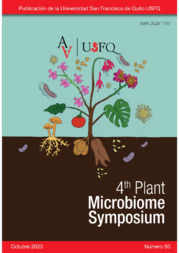Rice straw recycling increased soil microbial functional diversity during the decomposition of rice straw.
Rice straw recycling increased soil microbial functional diversity during the decomposition of rice straw.
Author(s): OTERO-JUMÉNEZ, V.; MURILLO, L.; CARREÑO, P.; MENDES, R.; VÉLEZ, D. U.
Summary: Vanessa Otero-Jiménez1 , Laura Murillo1 , Pilar Carreño1 , Rodrigo Mendes2 , Daniel UribeVélez1 1Agricultural Microbiology Group, Biotechnology Institute, National University of Colombia. Bogotá – Colombia. 2 Laboratory of Environmental Microbiology, Embrapa Environment, Jaguariuna – Brazil. Agricultural residues are precursors of soil organic matter, its decomposition in the field allows the entry of carbon and other nutrients into the system. However, it can also favor the proliferation of pathogens, converting it into a great challenge for producers. Among the alternatives to waste management are, burning of rice straw and/or its incorporation into the soil. However, the knowledge of the impact of these strategies on the microbial community and especially in their functionality is limited. This study sought to determine the effect of the application of four rice straw management strategies, on the structure and function of the microbial communities associated with the biogeochemical cycles of carbon (C), nitrogen (N), and phosphorus, those strategies are: 1. Leave rice straw as a mulch; 2. Rice straw as a mulch with the addition of microorganisms; 3. Rice straw plus microorganism inoculum followed by incorporation into the soil; 4. Burning of rice straw followed by ashes incorporation into the soil). A field trial was implemented with a random incomplete block design, sampling soil three times during a cultivation cycle. The soil was characterized by physicochemical and enzymatic analyzes, the microbial communities were described using shotgun metagenomics. Productivity and phytosanitary status of the rice crop were determined. The results showed differences in pH, enzyme activities, and microbial community at initial and degradation time compared to final time. Genes related to diverse processes of the N cycle as nitrogen fixation, nitrification, denitrification among others were identified. Regarding the C cycle, glycosyl hydrolases with action on hemicellulose increased especially at degradation times. This study suggests that the strategies of using rice straw, either as mulch or incorporated in the soil with microorganisms, are an adequate option for the final disposal of the rice straw, as agricultural practice to improve sustainable agricultural systems.
Publication year: 2023
Types of publication: Abstract in annals or event proceedings
Unit: Embrapa Environment
Observation
Some of Embrapa's publications are published as ePub files. To read them, use or download one of the following free software options to your computer or mobile device. Android: Google Play Books; IOS: iBooks; Windows and Linux: Calibre.
Access other publications
Access the Agricultural Research Database (BDPA) to consult Embrapa's full library collection and records.
Visit Embrapa Bookstore to purchase books and other publications sold by Embrapa.

